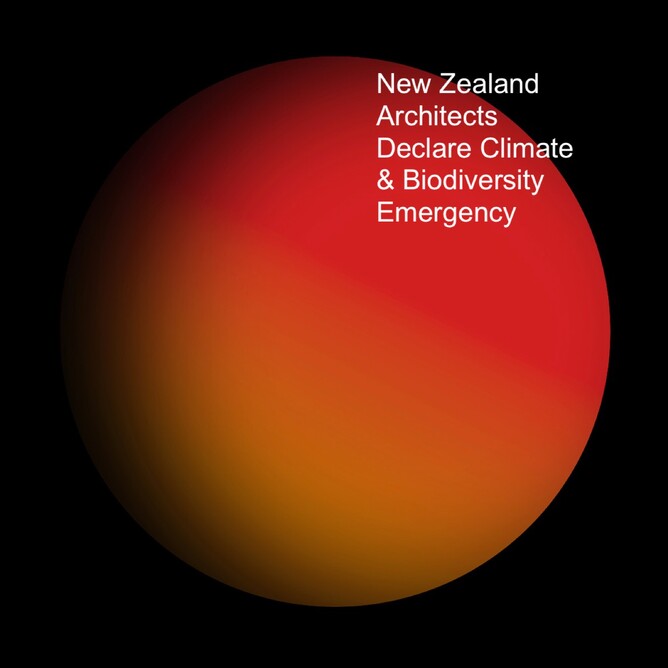All ten living recipients of the NZIA Gold Medal , including Andrew Patterson, Pete Bossley and Pip Cheshire are among the founding signatories of Architects Declare NZ, a commitment that aims to create architecture and urbanism that has a more positive impact on the world around us.
Formed on the 27th September 2019 by architects Siân Taylor from our own Team Green Architects and Duncan Sinclair of Black Pine Architects in Whanganui, the declaration follows on from similar declarations by UK and Australian architects, and lays down a set of guidelines that signatories pledge to follow in order to help prevent irreversible damage from a changing climate. The construction industry accounts for up to 40% of energy related carbon dioxide emissions, meaning architects can play a large part in helping to quell these emission rates.
For more information or to join the declaration please go to http://www.architectsdeclare.n...
The Starting FOUR
The founding members of Architects Declare met in Auckland in October 2019 to discuss how to move the Declaration towards Action. There is much that needs to happen within New Zealand, as is recognised in the recent NZGBC Zero carbon Road Map, and even the 11 declarations we have all made can have an overwhelming “where do I start” effect.
The following information is designed to indicate the smallest moves which can invoke the biggest impact, and begin affecting the change we all seek to make. This is a list of only four ideas , which are listed from a) easiest to the hardest, and b) least resource or change in architecture, through to more change/action required. Green links are additional information.
1. Promote the best windows & glazing as possible for any project
Why? This is the biggest low hanging fruit – and easiest way for us to make a difference- By tackling windows and glazing we can have the biggest single impact on the that is being locked into buildings for their lifetime. The more glazing/window area the bigger the impact.
- Why? - Glazing/windows is the weakest link in our building fabric. Branz tells us that where the window accounts for only 10% of the surface area of a building, this accounts for between 30 – 50% of the heat loss of the building. It is also responsible for the majority of the overheating. This means increased energy usage through either heating or cooling. The more windows there are the bigger the problem. If we just increase the insulation but don’t look at windows we have negated to address the weakest link in our buildings. See attached a slide from the NZIA and Prefab NZ thermal webinar earlier this month by Shawn McIssac (Oculus), for a graph showing the point when adjustments to the thermal insulation make no difference when windows are not tackled - at only 30% glazing. Very interesting….especially as we love lots of glass and indoor outdoor flow in NZ. This is a very good webinar – worth watching and available here.
- Aluminium (non-thermally broken frames) are inadequate, the outcome of using them is not only increased energy use, it creates a place where condensation forms, which over time turns into mould. So windows in New Zealand are not only the most responsible for in use carbon of our buildings they the weakest link responsible for the poor health of our buildings.
- By changing the windows and glass to a better solution, the architecture doesn’t have to change.
- Promoting better frames (if aluminium frames, ensure they are thermally broken). There are options for curtain walling as well as residential frames. We have at least ten suppliers of high performance (non-PVC) aluminium, timber and timber/alu windows in NZ now
- Promoting better glass – Low E see here for technical brochure from Metro Glass: by cross referencing the glazing option table and the NZ winter and summer climate maps in this brochure, suitable glazing options can be selected to keep buildings warmer in winter and cooler in summer (reducing the need for additional energy use).
- Promoting Thermal Edge spacers. – such as the warm edge.
- Promoting recessed frames, to be within the insulation layer of the building. This requires custom flashings and confirmation from cladding manufacturers that they accept a revised detail before submission to Local Authority. Attached is an image of two ways with NZ Aluminium windows we have achieved this. One is with a frame by Altus/Vistalite (which can be triple glazed) and is designed to be recessed. The other is a more common thermally broken frame with custom flashing.
2. Avoid Toxic ☠️ Materials in our buildings
Why? They are toxic….need I say any more…To us, the air, the soil, the ecosystems, the planet…
How? The Declare label is a fantastic source as this provides the Red List to avoid, and a gives a list of Red List Free products - for more information on what this is look here
3. Energy Model our buildings:
Why? This provides tangible/real information on the gut feel design decisions we are all making. It also provides the info needed to convince clients of the cost benefit to promoting a better thermal fabric to a building.How? Options for energy modelling software are as follows
- BIM and CAD Tools:
- ArchiCAD (Has in-built energy evaluation, but for a better option can have an add on - ECO Designer * which has thermal bridge assessment included.
- Revit ( I believe also has in-built energy modelling software).
- Trimble Sefaira
- EXCEL Tool:
Passive house Planning Package (PHPP) Note: This has been proven to be the most reliable software available with actual energy in-use typically being less than that which is modelled. (often this is the opposite). It also allows us to do a series of variants – which is alternative options for windows/walls/roof/ floor etc, which we combine with cost information to do a cost benefit analysis of where is the best place for a client to spend their budget (getting the most bang for buck). It also the invariably allows us to prove that large capacity heating or cooling is not required, so this is an immediate saving and allows more $$ to be spent on the thermal envelope or in design. Only 20% or so of this intensive spreadsheet needs to be used to get out the good information. If anyone wants to know more – contact me or Duncan, as we are using it on every project. - Other separate software: Energy Model Plus, AccuRate
4. Life Cycle Analysis of our buildings
Why? This provides a further level of actual information of the impact of our buildings.
How? Branz have created LCA Quick which is a free tool which enables us all to do Life Cycle Analysis of our buildings. I am yet to use this, but intend to check it out as the next stage.
Declarations targeted with the above 4
In BOLD is a highlight of the 11 declarations which are being tackled with the above suggestions.
1. Raise awareness of the climate and biodiversity emergencies and the urgent need for action amongst our clients and supply chains.
2. Advocate for faster change in our industry towards regenerative design practices and a higher Governmental funding priority to support this.
3. Establish climate and biodiversity mitigation principles as the key measure of our industry’s success: demonstrated through awards, prizes and listings.
4. Share knowledge and research to that end on an open source basis.
5. Evaluate all new projects against the aspiration to contribute positively to mitigating climate breakdown, and encourage our clients to adopt this approach.
6. Upgrade existing buildings for extended use as a more carbon efficient alternative to demolition and new build whenever there is a viable choice.
7. Encourage life cycle costing, whole life carbon modelling and post occupancy evaluation as part of our basic scope of work, to reduce both embodied and operational resource use.
8. Adopt more regenerative design principles in our studios, with the aim of designing architecture and urbanism that goes beyond the standard of net zero carbon in use.
9. Collaborate with engineers, contractors and clients to further reduce construction waste.
10. Accelerate the shift to low embodied carbon and non-toxic materials in all our work.
11. Minimise wasteful use of resources in architecture and urban planning, both in quantum and in detail.

